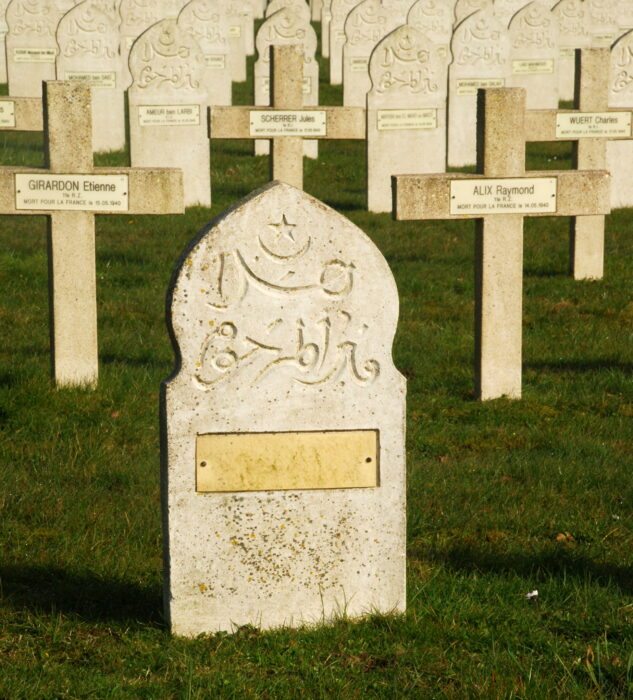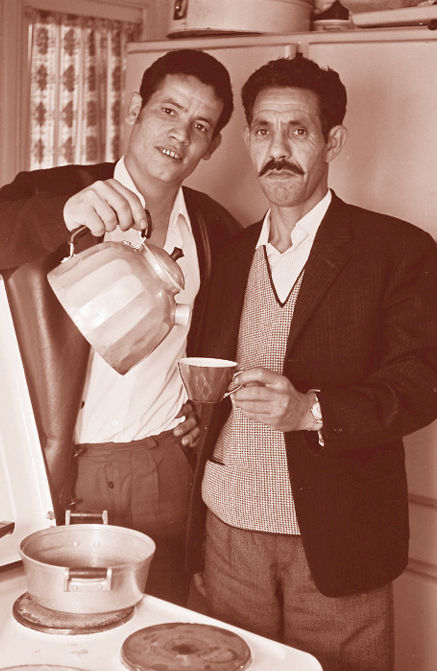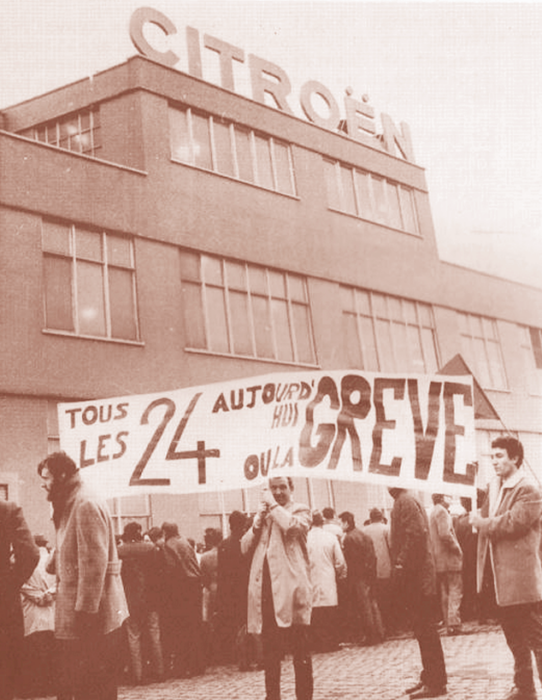Today, some 600,000 Moroccans live in Belgium, 340,000 in the Netherlands, and some 2,000 in Luxembourg: these three countries form the Benelux, an economic and customs union born in September 1944. Demographically speaking, this is the second largest MRE community in Europe with the largest Maghrebi community.
The official history of « Nass Belgica », as the Belgian-Moroccan community is known, began on February 17, 1964 with the signing of the Convention on Immigration between Belgian and Moroccan ministers Léon Servais and Thami El Ouazzani.
Nass Belgica, the assault on coal

As you might expect, Moroccan migrants didn’t rush to the Belgian border on February 18, 1964. Their voluntary exile had begun long before. Probably in dribs and drabs in the 1920s: a cross-border migration from northern France, where the North African presence was already felt.
Then, even though military mobilization was a specific form of migration, Moroccan goumiers and tirailleurs fought on the Gembloux-Wavre front in eastern Belgium in May 1940, under the orders of General de Lattre de Tassigny, to stem the German advance. 2,400 Moroccans paid with their lives. They are buried today in Chastre, a commune in Wallonia.

The first census of Moroccan nationals in Belgium took place in 1960, four years before the signing of the famous convention. More than 400 Moroccans were counted, some of whom claimed to have been living there since the inter-war years.
The 1964 convention, an open door for Moroccan migrants
Let’s return to the symbolic date of 1964. Who are these Moroccans in Belgium? What are they doing in Belgium? As in France, the first migrants did not come indiscriminately from one region or another of the Cherifian Kingdom. They mainly come from the outlying mountainous regions of Morocco. Roughly speaking, 80% come from the Rif mountains and 20% from the Atlas mountains.

They are first and foremost miners, construction workers and metalworkers. The majority are employed in coal mining. For the record, the European Union did not yet exist. Until 1957, the forerunner of the EU was the European Coal and Steel Community (ECSC). The acronym dispelled any doubts about the two strategic raw materials in Western Europe: coal and steel. And Belgium, an old industrial country, has a subsoil rich in coal and iron. That’s why the first Moroccans settled in the coal mines of the Borinage and Liège regions.
By the mid-1950s, Moroccans were already crossing the border. From the mines of Nord-Pas-de-Calais to those of Wallonia. In 1957, at Brussels’ request, some 300 workers were sent to work in coal mines in the flat country. In 1962, the General Manager of Fédéchar, the powerful Belgian federation of coal-mining companies, was in contact with the Belgian Consul General in Casablanca. Satisfied with the service record of Moroccan miners, the coal employer’s association was desperate to recruit more Moroccan miners.
A year later, in April 1963, Fédéchar moved up a notch. It decided to open a recruitment office in Casablanca. This was the prelude to the signing of the Belgian-Moroccan Convention of February 17, 1964 mentioned above. « The 1964 convention mainly organizes and formalizes recruitment for the Fédéchar, » points out Ahmed Medhoune in a collective work, L’immigration marocaine en Belgique, mémoires et destinées(2015).
Future MREs are pre-selected, with a psycho-technical test. A word of caution. Coal mining isn’t the only industry. Other trades, such as construction and public works, are looking for workers. Such is the case of the Belgian National Construction Confederation.
In any case, they went so far as to promote « Living and working in Belgium » to Moroccans, as the title of a brochure from the time indicates: « You who have just arrived in Belgium to live and work, the Minister of Employment and Labor wishes you a very warm welcome, on behalf of the Belgian people« . And the first reactions did not belie the brochure.
Pierre Clerdent, governor of the Province of Liège at the time, reacted to the report by French demographer Alfred Sauvy, which warned of the decline of the Walloon population, by welcoming the Moroccans and their demographic potential. « It was the same Baron Clerdent who, as early as 1964, suggested to the Liège municipal authorities the creation of an ‘Islamic plot‘ in the large Robermont cemetery, which was to be completed in 1969, » write political scientists Hassan Bousetta and Marco Martiniello in the journal Hommes et Migrations (2003). And in 1963, 500 workers left the Kingdom. This figure quadrupled the following year: 3,000 joined the Belgian coal mines.
Although France is the country of choice for Moroccan and North African emigration, once in France, Moroccan migrants wanted to explore other, almost similar horizons: those of the Benelux countries. Let’s follow in the footsteps of these neo-muhajirun in the center of Western Europe…. pic.twitter.com/z84WEUK8uZ
– TelQuel (@TelQuelOfficiel) March 26, 2025
Very quickly, the 1964 framework agreement proved insufficient to deal with the reality of migration, which had become a societal fact rather than a simple socio-political project. Practical and administrative problems, such as social security and family allowances, were emerging. A new agreement was therefore signed in Rabat in 1968, and ratified in the Belgian capital three years later. « It is based on three general principles: application of the legislation of the place of work, equal treatment of Belgian and Moroccan workers, and application of the rule of totalization of insurance periods and the prorata temporis rule », explains Belgian historian Anne Frennet-De Keyser in the magazine Courrier hebdomadaire (2003).
Subsequently, it’s no exaggeration to describe the « Golden Sixties » of Moroccan migration to Belgium. During this decade alone, over 125,000 work permits were issued. These figures obviously do not include irregular immigration. Many Moroccans arrive on tourist visas, and end up being hired.
Oil crises and migration crisis

Nevertheless, the warning shot was not long in coming. « In 1967, new legislation closed employment to immigrants, but allowed the wives and children of migrant workers living under the same roof to benefit from a work permit, creating a new potential workforce. In 1968, the official recruitment of Moroccans came to an end, » recalls historian Florence Loriaux. The die was cast. Immigration became increasingly restricted, especially from 1974 onwards, following the first oil crisis (late 1973).
This was also the year when the MREs began to realize that their rights were being trampled underfoot. A first strike in late spring 1974 was followed by a mass expulsion from Brussels’ Zaventem international airport. Gradually, the story of Moroccans in Belgium was transformed into a Belgian-Moroccan one, with MREs taking control of their civic destiny by getting involved in politics and associations.
The Netherlands and Luxembourg, late replacement migration
Moroccan emigration to the Netherlands came a little later, starting in the late 1960s. It wasn’t until May 1969 that a migration agreement was signed between the two kingdoms. This relatively late opening can be explained in part by history – the Netherlands had not been present in the Maghreb – but also by the country’s low level of industrialization, as well as its subsoil, which was less rich in raw materials than that of the surrounding European states. Moreover, until the Second World War, the Netherlands was a land of emigration, especially to the New World.
As in France and Belgium, the Moroccan migratory contingent in the early days came mainly from the Rif mountains and the Berkane region in the Oriental. There was also significant cross-border migration from northern France and Wallonia to Holland. This began in 1965. In that year alone, an estimated 5,000 Moroccans moved to the Netherlands.

From the mid-1960s to 1973, the number exploded. By the early 1970s, 14,000 Moroccans were working in the Netherlands. For the country, this was a response to labor shortages in certain industrial sectors, jobs to which the Dutch were generally reluctant. Moroccan migrants are then « guest workers », in other words, they are expected to return to the « bled » once their contract is up. But the Moroccan-Dutch community swelled rapidly from 1975 onwards, mainly through family reunification. The first wave was made up of single workers. Once they had settled down in their host country, they wanted to bring their relatives. This shift in the migration paradigm has a direct impact on the gender distribution of the Moroccan population. In other words, it’s becoming more feminine. The statistics speak for themselves. From around 800 women in 1972, this figure had risen to 25,000 by 1980.
The early 1980s also saw a growing political awareness of the issue of migrants. « For the first time,the concept of ‘ethnic minority’ appeared, to consider immigrant communities as ethnic groups with equal dignity and sharing the same conditions in the host society. This integrationist and even assimilationist vision sees immigrants as groups (or pillars) in addition to other existing groups, whose vocation is to integrate into Dutch society« , asserts anthropologist Zoubir Chattou in his book Migrations marocaines en Europe, le paradoxe des itinéraires (1998).
As in Belgium, a former colony and dependency of the Netherlands until 1830, Moroccans and foreigners in general are referred to as « pilarisation » (a system based essentially on religious and political opposition, editor’s note) and « allochtonie » (referring to a group’s foreign origins, editor’s note), two notions specific to the Benelux countries, unlike France, where they do not apply. But this hasn’t stopped the Dutch from progressively closing the country’s borders. The main argument? First and foremost, to improve living conditions for Moroccans and migrants already present on Dutch soil. In this respect, the Netherlands is a pioneer compared to its Western neighbors. No other member of the EEC pursues such a cutting-edge integration policy as the Netherlands.
Luxembourg, the small thumb of emigration
Last but not least, the last of the Benelux countries is the smallest geographically speaking. Luxembourg is a minnow when it comes to emigration. Nevertheless, it also welcomes Moroccan migrants. Very few. The latter are not rooted in any short- or medium-term history. It has to be said that the Grand Duchy’s MREs are the hidden face of studies on Moroccans around the world. No serious study, either by the Hassan II Foundation or a university, has examined the fate of the few thousand Moroccans who have settled here.
All in all, if the 1960s were the golden age of Moroccan migration to the Benelux countries, which seemed like El Dorado, it has to be said that today, the gold is rusting. With the far-right coming to power in Amsterdam, and a Flemish nationalist independentist in Brussels, Moroccans living abroad have much to be disappointed about in a Europe eaten away and oxidized by xenophobia.
Written in French by Farid Bahri; edited by AngloMedia Group




